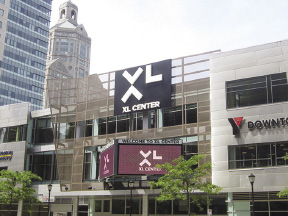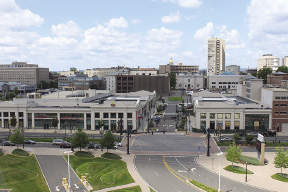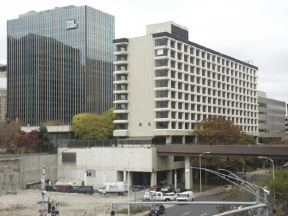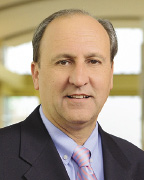Quietly, and until lately some might say imperceptibly, there have been a series of decisions that have converged with changing demographics and marketplace dynamics in downtown Hartford improving the city's outlook. How all these forces come together in the next business cycle will play out along multiple fronts. The value of real estate to current owners, prospective investors and developers should soon reflect these changes.
Essential Components
Among these, is the State of Connecticut's decision to relocate nearly 3,300 employees to the downtown core, consuming nearly 900,000 s/f of commercial business overhang and thereby reduce the current vacancy rate to below 20%, into the high teens. What will this mean to rental rates, building values and corporate movement? More critically, how much additional discretionary income will flow because of the increased downtown labor force and from the estimated 100,000 annual visitors to the state offices?
Then there is the state's decision to construct a new downtown campus for its flagship University, bringing 2,500 students and faculty to the Front St. redevelopment area. The addition of the UConn branch to a district that includes the Connecticut Convention Center, the Wadsworth Atheneum, the Connecticut Science Center, corporate towers like the Travelers and Phoenix, federal and municipal buildings, and several housing initiatives, redefines this strategic development center.
Governor Malloy's strategy to align the three large regional visitor and entertainment venues: the XL Center, the Connecticut Convention Center and Rentschler Field under one quasi-state agency allows for economy of scale and the optimization of marketing opportunities. Further, the State's recent announcement to commit significant capital improvement funds to the XL Center is matched by the private dollars of Comcast Global Spectrum, the buildings new management firm.
A major new transit system, known as the CTfastrak, along a dedicated right of way is under construction linking the western suburbs direct to the downtown. Redesigns to the current city transit infrastructure will accommodate the new line linking commuters and visitors to key downtown destinations. Transit-oriented development projects are evolving in expectation of the new line.
Last, but not the least important to this evolving scene are residential developments in the city's center. The Brookings Institute reported last year that the Nation's 50 largest metro areas grew faster than the suburbs for the first time in nearly 100 years. The cities are becoming younger, more diverse, have smaller households with a new generation that demands more entertainment, cultural events and specialty retail and does not want to commute. Providing more urban residential living to meet this demand that reflects the future and not historical patterns of absorption or use has become the new local strategy.
Hartford has twice as many people living downtown as it did in 1980 with 67% of the units occupied by single person households. Another 14% of the downtown population is married, but has no children. The impact of more college students has yet to be felt. The city has seen this curve and is working to capitalize on it and a variety of projects are positioning in the current marketplace with a residential vacancy rate of 3% and rents that are now approaching and for some projects, breaking the $2/s/f threshold.
Today, nearly a doubling of the downtown residential population is underway with over 1,000 units of market rate housing in the pipeline, leveraged by the Capital Region Development Authority, a newly created entity to spur further renewal. Another 1,000 are planned, thereby tripling the residential marketplace. The units include newly constructed buildings as well as the conversion of secondary and underperforming commercial buildings including class B offices and former hotels into market rate units. This will further impact the vacancy and rental rates of the commercial market and will lead to increased retail strength.
The former 300,000 s/f Bank of America office tower will be converted into 286 units by Becker Development which has had success in nearby New Haven with a similar product. The former Sonesta hotel is being restored by Girona Capital/Wonderworks partnership out of New York into 193 units. Several smaller class B buildings are converting from low effective commercial rents to higher residential rental rates. New construction is about to break ground in the form of four story frame construction of 121 new market rate units by H.B. Nitkin of Greenwich. Other conversions are contemplated for closed mill buildings and several historic structures, one into 63 market units by Dakota Partners of Waltham Mass. and another proposed by the owners of a mixed historic building downtown. A second wave of conversions and new construction is already queuing up, many at the edges of the central business district, effectively reconnecting with nearby neighborhoods that ring the city's Bushnell Park and State Capitol Grounds.
On Front St., the last component of the state's decade long investment into Adriaen's Landing, has crossed the tipping point with two-thirds of its original 60,000 s/f of commercial space occupied. Spotlight Theatre will soon be joined by Infinity Music Hall and Bistro, Capital Grille steak house, and a mid-priced family restaurant that will lease approximately 4,500 s/f of space. Other tenants are in discussion as the area prepares for the new housing and the University of Connecticut - Hartford campus.
The capital is about to join its sister cities, Stamford and New Haven, and see growth in its downtown core of residents, venues, cultural institutions and business expansion. In a state that prides itself of "steady habits" and has experienced little growth over the last few years, a gradual change is occurring.
Mike Freimuth is the executive director of the Capital Region Development Authority, Hartford, Conn.













